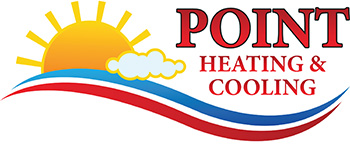
Ceiling fans are one of the most underrated ways to make your home more comfortable and lower energy costs. By enhancing air circulation and working in conjunction with your HVAC system, ceiling fans and energy efficiency are truly a natural pairing. They offer a practical, energy-efficient way to stay cool while easing strain on your AC—helping you avoid unnecessary air conditioning repair.
In this blog, the experts at Point Heating & Cooling explain how ceiling fans can keep you cool while avoiding energy waste with increased HVAC efficiency. We'll also offer some HVAC efficiency tips that make the most of ceiling fans.
Comfort vs. Temperature: The Effect of the Wind-Chill Effect Indoors
Ceiling fans don’t actually change the room’s temperature—they make you feel cooler by moving air over your skin. This is called the wind-chill effect, and it can make a room feel up to 4 degrees cooler without adjusting the thermostat. That means you remain cool and enjoy the benefits of indoor air circulation from your ceiling fan while minimizing air conditioner use—helping reduce your electric bill in summer.
The Best of Both: Why You Should Use Fans and Air Conditioning Together
There are several advantages to using ceiling fans and air conditioning together, especially during the warmer months. By combining both, you maximize HVAC efficiency and keep your home cooler with less strain from your cooling system.
Top perks of using ceiling fans and AC together:
- Ceiling fans help lower HVAC load by distributing cool air more evenly throughout rooms in your home. Decreasing HVAC stress is important, because it can save you from a breakdown that could lead to premature AC or furnace installation.
- Using ceiling fans boosts the comfort level of your home by reducing uneven temperatures and improving air movement.
- Running both ceiling fans and AC can reduce overall energy use. If you have a home automation system, you can even fine-tune your smart thermostat settings to increase the temperature slightly while your ceiling fan is running.
Clockwise vs. Counterclockwise Ceiling Fan Rotation: Which Direction Should a Fan Spin?
To make full use of your ceiling fans year-round, it’s important to ensure blades are rotating in the right direction for the season. The direction impacts how air moves, which can either cool you down or redistribute heat so you feel warmer.
When to spin ceiling fans counterclockwise
On hot days, ceiling fans should turn counterclockwise at a faster setting. This creates a breeze that moves air toward the floor, increasing the wind-chill effect and causing you to feel cooler.
When to spin ceiling fans clockwise
On cold days, set your fan to turn clockwise on a gentle setting. This lifts cooler air and circulates heated air down to where you can feel it, making the space feel cozier without touching your thermostat.
Things to Look for in a Ceiling Fan
Selecting the ideal ceiling fan depends on a few critical considerations, including blade design, airflow rating and room dimensions. First, look for fans that offer a good combination of ECFM airflow and blade pitch to ensure efficient air circulation in your home:
- ECFM is how much air a fan circulates—the cubic feet per minute, or CFM—per watt of electricity it uses. Fans with greater ECFM are more energy efficient.
- Blade pitch refers to the tilt of the blades. A steeper blade pitch moves more air but can also put extra load on the motor.
Also, consider room size when sizing a ceiling fan—a fan that’s too small won’t circulate sufficient air, while one that’s too large may be disruptive in a smaller room.
Increase Your HVAC Efficiency With the Experts from Point Heating & Cooling
At Point Heating & Cooling, our HVAC specialists can help you enjoy year-round comfort while easing the burden on your heating and cooling systems. From efficient ceiling fan strategies and air conditioning installation to smart thermostats and furnace repair, we offer comprehensive services that match your needs. Schedule your appointment by calling 715-814-9741 today.
